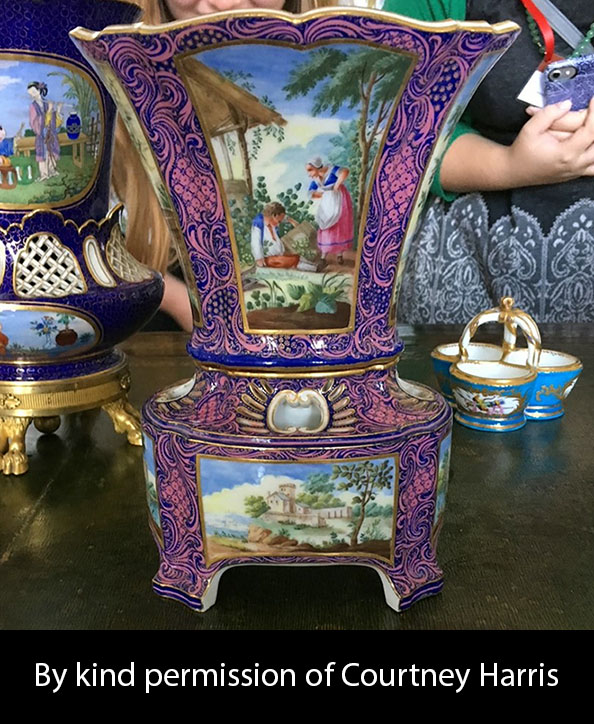
Elements of the farmhouse/hunting lodge, which forms the earliest core of the house. From a 1907 postcard.

The 1761–62 Sèvres soft-paste purple porcelain flower vase (vase hollandois nouveau ovale) that was once in the collection at Daws Hill House. This vase is today in the collection of Firle Place.
House & Family History: Daws Hill began as a farmhouse in the 18th century; it was later rebuilt as a hunting lodge, and then greatly enlarged into a country house in the early 20th century for the 3rd Lord Carrington. The house contains a carved marble chimneypiece that was removed from Carrington House, London, paneling from Gayhurst House, and ceiling panels by Angelica Kaufmann. During World War II, when Wycombe Abbey was requisitioned by the British government as HQ for 8th Bomber Command for the U.S. Army Air Force, Daws Hill House was included as part of requisition.
Collections: Christie's sold the contents of Daws Hill House in 1928, after the death of the 3rd Lord Carrington. At that sale a 1761–62 Sèvres soft-paste porcelain flower vase (vase hollandois nouveau ovale) was sold (lot 46); this important piece was purchased by the noted collector Forsyth Wickes, who bequeathed it to the Museum of Fine Arts, Boston, at his death in 1964. This vase was one of a pair originally at Daws Hill; the mate to the MFA's piece is today in the collection of Firle Place (see "Images" section). The vase at Firle was probably purchased by a member of the Gage family at the 1928 sale.
Garden & Outbuildings: During World War II a large encampment of tents and huts was constructed within the Wycombe Abbey parkland (the Daws Hill Estate is part of the Wycombe Abbey Estate). The estate also contains a Grade II*-listed decommissioned nuclear bunker that was once part of the Ministry of Defence's RAF Daws Hill. The 23,000-square-foot underground bunker housed high tech equipment for the direction of nuclear bombers and guided missiles and was an important part of U.S. Strategic Air Command operations based in Britain during the Cold War. Because of its nuclear weapons, especially cruise missiles, the site was frequently the site of protests; between 1982 and 1985 there was a also peace camp nearby. After the U.S. Navy used it for U.S. Visiting Forces in the early 2000s, the site was transferred to the RAF in 2007; in 2011 most of the land was sold to a property developer, Taylor Wimpey Plc, who created a housing estate of approximately 450 homes called Pine Trees on the site.
House Listed: Grade II
Park Listed: Not Listed
Past Seat / Home of: Robert Smith, 1st Baron Carrington, until 1838; Robert John Carrington, 2nd Baron Carrington, 1838-68; Charles Robert Wynn-Carington, 3rd Baron Carrington and 1st Marquess of Lincolnshire, 1868-1928.
Current Ownership Type: School
Primary Current Ownership Use: School
Ownership Details: Today part of Wycombe Abbey School
House Open to Public: No
Phone: 01494-520-381
Email: [email protected]
Website: https://www.wycombeabbey.com/
Historic Houses Member: No